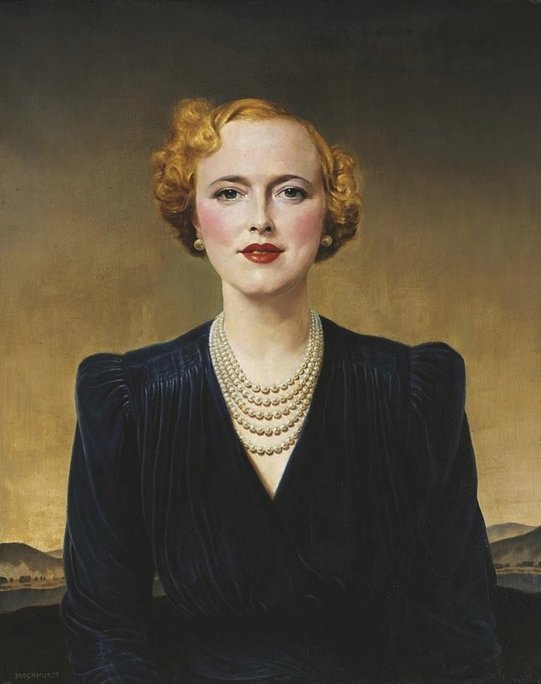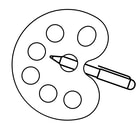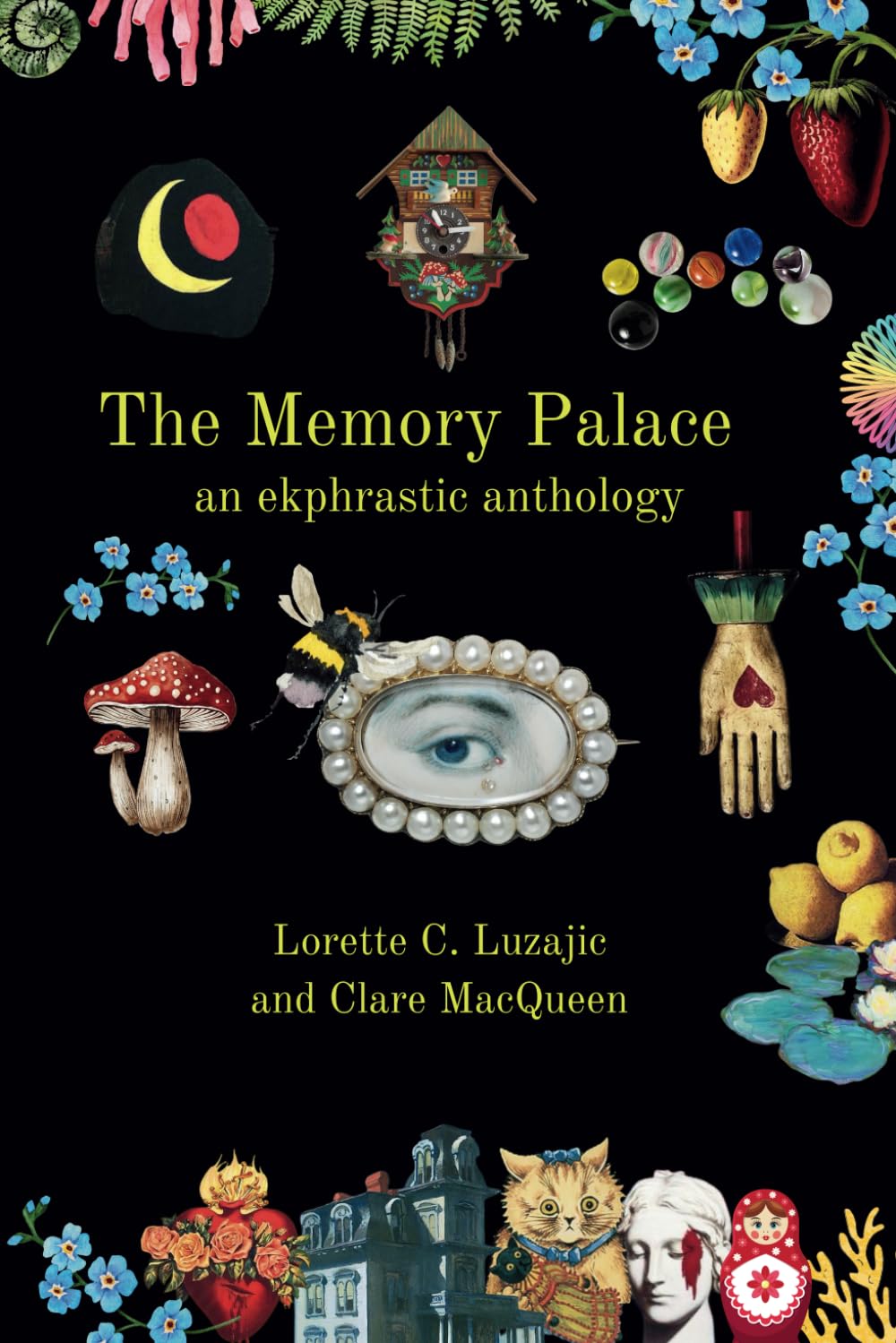|
J. Petrinovic, to Her Viewer The following interaction with Gerald Leslie Brockhurst’s Portrait of J. Petrinovic was recorded in the University's art gallery Nov. 13, 20__ Yes, it is me you hear. It happens, rarely, but sometimes. Look at my portrait. Please see me, or at least how Brockhurst, as he had me call him, painted me. Don’t follow your gentleman into the next room. I need you more. Stay. I heard the disdain with which he spoke. It’s how my husband and Brockhurst talked to me. Maybe that’s why you can hear what so many do not. We share circumstances, perhaps? You are his girlfriend? Mistress? Wife? Did he present you those beautiful pearls and the matching teardrop earrings, or did you buy them? They frame your face perfectly, and I hope they memorialize a happy occasion. I purchased these graduated pearl strands from money my husband gave me to help me get over the loss of my daughter at the hand of that low, alleyway doctor to whom he sent me. Do I see sadness in your face? Can I help? In life, I desperately wanted a friend with whom to share my story, trust in her response, and be, in return, her giving mirror. Instead, I am now an unsympathetic figure, my background a few hills and indistinct light, hung here unable to offer or receive comfort. Those who knew me in life are gone, and I am eminently forgettable to the relative few who take more than a moment to glance inside my frame. At least the docents find me useful. A few times each day they gather groups before me, offering the same introduction each time: “With portraiture, the artist paints a story you get to tell about someone you didn’t know.” Then they ask for a story, and the criticism begins. My jaw is too prominent; my blush or lip paint too obvious; my hair too severe, parted on the wrong side with an auburn shade unlikely for my colouring; my look accusing. I am not heroic like the woman seen around the corner on a Jacob Lawrence panel. I am just a stuck-up bitch, one young person said. Can you imagine such a horrid phrase? How can people think they know me like that within seconds? Your clothes, like mine, are fashionable, not flapperish. Do people talk of you as they do me? The nice things said, such as they are, are voiced by children. A particular boy and another girl said I was pretty, but then said no more after their teacher hectored them to explain why. In another group, a few children decided I must be rich, and they would be nice to me so I would buy them lunch, new clothes, sneakers, and maybe even video games. For nearly every adult visitor who comments, I am the stooge they compare to my neighbors on this wall. Many see me lacking in natural graces juxtaposed to the innocence and natural beauty they find to my left in the smaller portraits by Milton Avery of a “Nanny,” and Daniel Huntington’s “Study of a Young Woman.” People’s faces light up with happiness when taking in Robert Henri’s young man, “Johnnie Patton,” to my right. A shadow falls as they shift their glance toward me. It suggests paranoia if I talk of conspiracy. Still, I occasionally wonder if the curators have hung me in some way to make the boy seem more heroic by comparison. He is here courtesy of the family for which this gallery is named. But that is madness, yes? The result of too much time to worry my fate. Brockhurst was celebrated and well compensated for making women glamorous with his brush and oils. His, I suppose, was the luster my husband wished to reflect through this commission. Everyone knew the artist’s history with women. His two wives often modeled for him because, like Edward Hopper’s wife, Jo, they foolishly thought reducing his intimate exposure to other women would keep him from cheating. During my sitting he joked about dabbing some of his wife into my features to keep her off the track. I did not accept or encourage his advances. Do I read in your eyes similar experience? Will you trust that I am not lying? I am not sure my husband did, leading to the argument over money between him and Brockhurst that leaves me—this portrait of me anyway—undated. The omission must imply to many observers I am unfinished … unworthy. Brockhurst would lecture while he painted and speak of how an artist attempts to capture the subject’s mind, brain, and especially her soul on canvas. Could there have been too much of the latter, which has given me this cursed afterlife? Was there too little, which is why nobody sees anything closer to the real me? Was I cursed into this eternal melancholy by his wife? My own husband? Perhaps I lost a competition—one I was most unaware of—with that debauchee, Margaret Campbell, Dutchess of Argyll. Her sitting overlapped mine. Our portraits are similar, although hers is commonly discerned as a finer example of his work. With forever to think, my mind stops, starts, and revolves on the same track like a boardwalk carousel. I am not, as I’d hoped, a figure inspirational and tragic, like the unknown woman of Poe’s “Oval Portrait.” Not a metaphoric expression of tortured artistry like Wilde’s closeted Dorian Gray. Regrettably, my definition has become what I am not—so much moreso than what I once was. Funny, when no guard or visitor obstructs my view, I spend hour after hour staring straight across the gallery at Jean Dubuffet’s mostly golden “Geomancier.” Visitors kindly describe that heavily layered oil abstract. Somehow it comes across as three-dimensional and inspiring of multiple interpretations, while I am two-dimensional and easily dismissed. One day Brockhurst described the book he was reading, Edwin Abbott’s “Flatland,” about a two-dimensional world. Could he somehow have whisked those ideas onto the palette, defining the woman you see here? Some of the women who stand in your place-- Wait. Please don’t leave because he calls. I know what happens if you let him choose your direction for you. I am what happens. I need you. Stay. Kent Oswald This story first appeared in Easy Street Magazine. Kent Oswald’s work has appeared in LA Times Book Reviews, Tennis Industry, Cigar Aficionado, Six Sentences, and elsewhere. He tweets @Ready4Amy and @CupidAlleyChoco
1 Comment
Norbert Kovacs
5/17/2017 07:20:01 pm
I enjoyed that this story came from the portrait's perspective. An interesting viewpoint to be sure. If only the paintings at the Met spoke to me as much...
Reply
Your comment will be posted after it is approved.
Leave a Reply. |
The Ekphrastic Review
COOKIES/PRIVACY
This site uses cookies to deliver your best navigation experience this time and next. Continuing here means you consent to cookies. Thank you. Join us on Facebook:
July 2024
|




